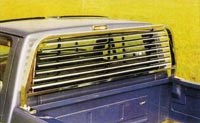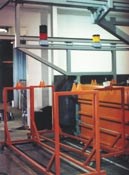Nickel Chromium Plating in Duncan, Oklahoma
Where else would people demand durable nickel chromium plating but on truck bumpers in cattle country...
When you hear the term Boomers, you most likely think of Baby Boomers. That multitude of babies born after WWII. Actually, one, if not the first, group of Boomers was from Oklahoma. This group pressured the U.S. government into opening rich lands (Oklahoma) to non-Indian settlement.
Since then, Oklahoma has been populated with a people proud of its heritage and land, with a spirit that echoes throughout its state. This can be seen in its famous citizens such as Will Rogers and athlete Jim Thorpe and its not so famous, yet just as accomplished, citizens Wayne Fish and his father, Dearl Fish. The Fish family owns and operates Southwest Plating in Duncan, OK.
Dearl and Phyllis started the shop in 1982 plating motorcycle accessories for the aftermarket. At the time, the shop consisted of 5×3-ft manual nickel-chromium plating tanks. Although Phyllis never allowed any imperfectly plated part to leave the shop, the family soon realized it had limited the amount and type of business it could do by the size of the tanks. When its main customer went bankrupt, the company was in trouble.
This didn’t stop the family, however. In 1985, the shop opened with two manual hoist lines dedicated to plating nickel chromium. Of course, the tanks were larger so that the company could plate bigger parts and larger orders, including truck bumpers, tubular products and wire goods used in grille protection hardware on trucks.
Trucks are essential in Oklahoma and Texas. Most trucks are ordered from the manufacturers without a bumper, since truck buyers like to add heavier duty bumpers after they purchase the trucks. This made truck bumpers big business in Oklahoma and Texas, both the manufacture of them and the plating of them.
In 1996, Wayne foresaw Southwest’s growth in this area. He knew that he needed to automate and install a system that could handle continued growth. In anticipation of this, he ordered a three-hoist automated nickel-chromium plating line. The 135-ft long line has 40 stations with 10-ft tanks that are 5-ft deep. Presently, three plating cycles are programmed into the system; however, the system can be programmed with up to 100 different cycles.
Quiet is what one first notices upon entering the plating shop. No clacking, ticking or ratcheting sounds accompany rack movement. The system has no AC motors for hoist control, nor does it rely on limit switches for positioning and shifting speed.
The system, from Integrated Process Systems, uses servo systems and encoders that provide closed-loop control for each motorized hoist for both horizontal and vertical axis.
The encoders eliminate limit switches on the process line and give direct feedback to the servo drive used for positioning. All tank positions on the nickel-chromium plating line are entered into the computer as fixed distances from the load/unload queue. This is the zero datum point in the program. The servo drive converts these distances into pulses. This positioning is achieved by receiving 2,000 pulses for each revolution of the motor shaft, positioning accuracy is repeatable within ±0.002 inch.
Southwest also decided on new chemistry for its plating line. It chose to work with A Brite Co. for its cleaners, plating chemicals and additives.
The cleaning cycle begins with a manual dip and hand scrubbing, if necessary, in a highly concentrated liquid soak cleaner for steel. The potassium-based, high-powered surfactants and detergents in the cleaner hold soils, including buffing compounds, in solution so that they do not redeposit on the parts. Initially, Southwest only planned to manually preclean heavily soiled parts, but the plating on parts that were manually cleaned turned out excellent, convincing Southwest to incorporate the practice on all its parts.
On the automated line, cleaning begins with a liquid electrocleaner that is pumped into the processing tank to eliminate hazardous dust and splashing. It is only available in liquid form and can be metered in as needed to maintain the bath concentration established for Southwest’s cleaning needs. This cleaner removes rust, scale and weld smoke and “wets out” the tubular products that Southwest plates.
To activate parts prior to plating, Southwest pickles the parts in a blend of acid salts, activators and surfactants. The pickle removes oxides, rust, heat treat scale and welding scale. It activates the bumper and wire surfaces without generating smut and minimally attacks the base metals. Within the pickle is another system that helps improve the descaling, activating and cleaning properties of the acid pickle. It reduces the surface tension of the pickle bath and allows for greater penetration of the acid solution into scale and metal pores.
After rinsing, parts are ready for plating in semi-bright nickel. The nickel-plating process at Southwest is a sulfur-free duplex nickel system that provides a highly corrosion-resistant deposit. Deposits on the bumpers, tubular and wire products are bright, leveled, very low stressed and readily accept subsequent plating without the need for coumarin or coumarin-based materials.
The bright nickel plating is designed with cleaner, stable organic compounds that enable the process to provide very bright deposits with maximum leveling and less need for batch treatment. The finish that Southwest achieves on its parts is white-bright and highly leveled. It is also quite ductile and low-stressed.
Because Southwest plates tubular parts and bumpers that have deep recesses, the bright nickel-plating process needed excellent throwing power. Southwest found that this particular process was able to reach into extremely low-current-density areas, producing a uniform plate across the entire part.
Another benefit Southwest discovered with the new nickel system was that it worked even when contaminated with zinc and copper impurities. Although Southwest uses nothing but DI water for rinsing and bath make up, and tank turnovers are 3-½ times per hour, it still likes having the assurance that the bath will produce perfect parts even if minimal amounts of contaminants should penetrate the system.
Rinse water filtrate is returned to the plating baths. Each rinse station features flow controls that operate incoming as well as outgoing water flow. Rinse stations after the nickel and chromium plating tanks are all triple counter-current rinses.
The decorative chromium plating process operates at a higher current density, yet doesn’t burn the parts. It also allows for faster plating and better corrosion resistance, which is necessary when plating the heavy-duty truck bumpers that Southwest plates.
To help with fume control, Southwest uses a permanent mist/fume suppressant that lowers the surface tension of the chromic acid bath to the regulatory surface tension requirement of 45 dynes/cm. This not only allows it to exceed NESHAP requirements, but also reduces dragout.
Waste treatment at Southwest is typical pH adjustment, settlement and filter press.
Southwest Plating is not only an example of Oklahoma spirit, but American entrepreneurial spirit. The company started out with a good, profitable idea, plating motorcycle parts. It just didn’t anticipate its number one customer going bankrupt. The best part is that it learned from its mistake, and when it started all over again Southwest was prepared to grow and prosper. It diversified its customer base and its finishing capabilities.
To learn more visit A Brite Company.
Related Content
Troubleshooting Alkaline Zinc
One of the most common problems that can arise when plating with alkaline zinc is an imbalance of brightener in the solution. In this helpful Ask the Expert article, Chad Murphy of Columbia Chemical discusses how different zinc metal concentrations and brightener concentrations can impact efficiency.
Read More3 Tests to Ensure Parts are Clean Prior to Plating
Making sure that all of the pre-processing fluids are removed prior to plating is not as simple as it seems. Rich Held of Haviland Products outlines three tests that can help verify that your parts are clean.
Read MoreSuccessful South African Plater Beating the Odds
Remaining focused on quality and reliability, Team Plating Works stays profitable in a volatile and challenging economy.
Read MoreNanotechnology Start-up Develops Gold Plating Replacement
Ag-Nano System LLC introduces a new method of electroplating based on golden silver nanoparticles aimed at replacing gold plating used in electrical circuits.
Read MoreRead Next
Episode 45: An Interview with Chandler Mancuso, MacDermid Envio Solutions
Chandler Mancuso, technical director with MacDermid Envio discusses updating your wastewater treatment system and implementing materials recycling solutions to increase efficiencies, control costs and reduce environmental impact.
Read MoreA ‘Clean’ Agenda Offers Unique Presentations in Chicago
The 2024 Parts Cleaning Conference, co-located with the International Manufacturing Technology Show, includes presentations by several speakers who are new to the conference and topics that have not been covered in past editions of this event.
Read MoreDelivering Increased Benefits to Greenhouse Films
Baystar's Borstar technology is helping customers deliver better, more reliable production methods to greenhouse agriculture.
Read More















.jpg;maxWidth=300;quality=90)










